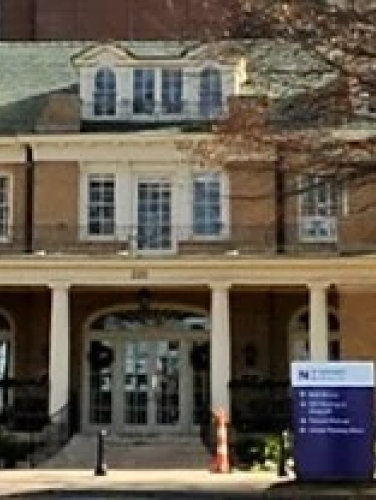
William Henry Belk House
(ca. 1924)
The founder of Belk’s department stores chose prominent Charlotte architect C. C. Hook to design one of the city’s most prominent homes.
200 and 220 Hawthorne Ln, Charlotte, NC 28204
One of the few mansions surviving on Hawthorne Lane, a once elegant residential street within the streetcar suburb of Elizabeth, the William Henry Belk House now sits in the shadow of Novant Health Presbyterian Medical Center, surrounded by acres of parking lots. When completed in 1924 William Henry (1862-1952) and Mary Irwin Belk (d. 1968), the house – designed by one of the city's greatest architects, Charles Christian Hook (1870-1938) – was one of Charlotte’s most prominent structures.
Property Quick Links
Belk rose from a South Carolina farm boy who lost his father in the Civil War to the head of one of the South's leading retail chains. After working for twelve years in the B. D. Heath store in Monroe, North Carolina, Belk left with $750 in savings to open his own dry goods business in the same town in 1888. He soon persuaded his brother, Dr. John M. Belk (1864-1928), to become a partner in the business. Their marketing strategies, novel for that era, resulted in success: selling quality merchandise at moderate prices for cash only; treating all customers with equal respect; and a no-questions-asked return policy.
The brothers opened their first store in Charlotte on September 25, 1895, in a rented store building just off the Square on East Trade Street. The Belk Brothers store enjoyed steady growth parallel to the city’s own rapid expansion from the 1880s to the end of the 1920s. By 1905, the business was doing so well the brothers bought a three-story building on East Trade to consolidate the store under one roof instead of operating out of several storefronts. The refurbished building with its fancy new facade opened in 1910 to live music at a gala grand opening. Fifteen years later, greater expansion was called for, resulting in a new store on the same site that was twice the width of the former store and five stories high, costing a quarter of a million dollars. When it opened in 1927, it was the largest department store in the Carolinas and the flagship of an ever-expanding chain of forty-two Belk stores. In the early 1920s, flush with the success of his business venture, Henry Belk hired C. C. Hook to design his 2-1/2 story, 16-room mansion. Henry’s success continued such that, by the time of his 1952 death, there were hundreds of Belk stores throughout the South. The house was donated to the hospital upon Mary’s death.
A native of Wheeling, West Virginia, C. C. Hook moved to Charlotte in 1890 to become the city’s first full-time professional architect. He is remembered as one of North Carolina’s most prolific architects in the early twentieth century. His design projects span the state, ranging from Romanesque Revival and Colonial Revival styles to Italianate and Beaux-Arts, although he is best known for his Colonial Revival designs. His Charlotte commissions included Charlotte City Hall, the U.S. Post Office and Courthouse, Fire Station No. 6, the Carolina Theater, the Charlotte Women’s Club, the Duke Mansion, and several houses in the Dilworth, Hill Crest, Colonial Heights, Wilmore, and Piedmont Park neighborhoods. Other notable works include Statesville’s Billingsley Hospital, Wilmington’s Elks Building, Blowing Rock’s Episcopal Church, and numerous collegiate buildings, including Phillips Hall at UNC-Chapel Hill, Patterson Hall at North Carolina State University, Eliza Pittman Memorial Auditorium at St. Mary’s College, Jarvis Hall at East Carolina University, Hayes Hall and four other campus buildings at Queens College, Spencer Hall at Greensboro’s State Normal and Industrial School now known as University of North Carolina at Greensboro, and Bivens Hall and Alumni Memorial Gymnasium at Duke University.

